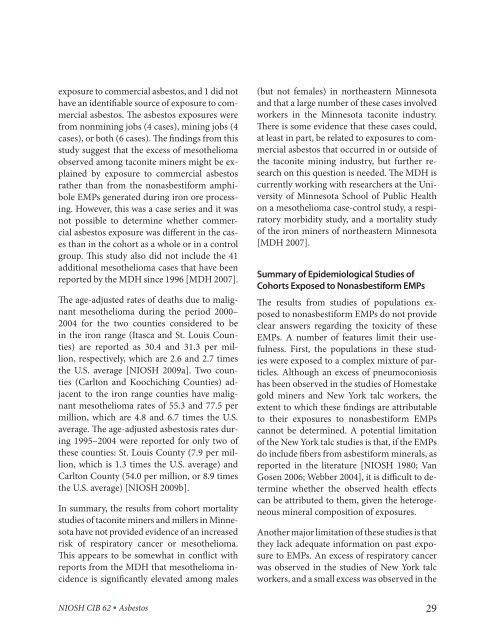Asbestos Fibers and Other Elongate Mineral Particles: State of the ...
Asbestos Fibers and Other Elongate Mineral Particles: State of the ...
Asbestos Fibers and Other Elongate Mineral Particles: State of the ...
- No tags were found...
Create successful ePaper yourself
Turn your PDF publications into a flip-book with our unique Google optimized e-Paper software.
exposure to commercial asbestos, <strong>and</strong> 1 did not<br />
have an identifiable source <strong>of</strong> exposure to commercial<br />
asbestos. The asbestos exposures were<br />
from nonmining jobs (4 cases), mining jobs (4<br />
cases), or both (6 cases). The findings from this<br />
study suggest that <strong>the</strong> excess <strong>of</strong> meso<strong>the</strong>lioma<br />
observed among taconite miners might be explained<br />
by exposure to commercial asbestos<br />
ra<strong>the</strong>r than from <strong>the</strong> nonasbestiform amphibole<br />
EMPs generated during iron ore processing.<br />
However, this was a case series <strong>and</strong> it was<br />
not possible to determine whe<strong>the</strong>r commercial<br />
asbestos exposure was different in <strong>the</strong> cases<br />
than in <strong>the</strong> cohort as a whole or in a control<br />
group. This study also did not include <strong>the</strong> 41<br />
additional meso<strong>the</strong>lioma cases that have been<br />
reported by <strong>the</strong> MDH since 1996 [MDH 2007].<br />
The age-adjusted rates <strong>of</strong> deaths due to malignant<br />
meso<strong>the</strong>lioma during <strong>the</strong> period 2000–<br />
2004 for <strong>the</strong> two counties considered to be<br />
in <strong>the</strong> iron range (Itasca <strong>and</strong> St. Louis Counties)<br />
are reported as 30.4 <strong>and</strong> 31.3 per million,<br />
respectively, which are 2.6 <strong>and</strong> 2.7 times<br />
<strong>the</strong> U.S. average [NIOSH 2009a]. Two counties<br />
(Carlton <strong>and</strong> Koochiching Counties) adjacent<br />
to <strong>the</strong> iron range counties have malignant<br />
meso<strong>the</strong>lioma rates <strong>of</strong> 55.3 <strong>and</strong> 77.5 per<br />
million, which are 4.8 <strong>and</strong> 6.7 times <strong>the</strong> U.S.<br />
average. The age-adjusted asbestosis rates during<br />
1995–2004 were reported for only two <strong>of</strong><br />
<strong>the</strong>se counties: St. Louis County (7.9 per million,<br />
which is 1.3 times <strong>the</strong> U.S. average) <strong>and</strong><br />
Carlton County (54.0 per million, or 8.9 times<br />
<strong>the</strong> U.S. average) [NIOSH 2009b].<br />
In summary, <strong>the</strong> results from cohort mortality<br />
studies <strong>of</strong> taconite miners <strong>and</strong> millers in Minnesota<br />
have not provided evidence <strong>of</strong> an increased<br />
risk <strong>of</strong> respiratory cancer or meso<strong>the</strong>lioma.<br />
This appears to be somewhat in conflict with<br />
reports from <strong>the</strong> MDH that meso<strong>the</strong>lioma incidence<br />
is significantly elevated among males<br />
NIOSH CIB 62 • <strong>Asbestos</strong><br />
(but not females) in nor<strong>the</strong>astern Minnesota<br />
<strong>and</strong> that a large number <strong>of</strong> <strong>the</strong>se cases involved<br />
workers in <strong>the</strong> Minnesota taconite industry.<br />
There is some evidence that <strong>the</strong>se cases could,<br />
at least in part, be related to exposures to commercial<br />
asbestos that occurred in or outside <strong>of</strong><br />
<strong>the</strong> taconite mining industry, but fur<strong>the</strong>r research<br />
on this question is needed. The MDH is<br />
currently working with researchers at <strong>the</strong> University<br />
<strong>of</strong> Minnesota School <strong>of</strong> Public Health<br />
on a meso<strong>the</strong>lioma case-control study, a respiratory<br />
morbidity study, <strong>and</strong> a mortality study<br />
<strong>of</strong> <strong>the</strong> iron miners <strong>of</strong> nor<strong>the</strong>astern Minnesota<br />
[MDH 2007].<br />
Summary <strong>of</strong> Epidemiological Studies <strong>of</strong><br />
Cohorts Exposed to Nonasbestiform EMPs<br />
The results from studies <strong>of</strong> populations exposed<br />
to nonasbestiform EMPs do not provide<br />
clear answers regarding <strong>the</strong> toxicity <strong>of</strong> <strong>the</strong>se<br />
EMPs. A number <strong>of</strong> features limit <strong>the</strong>ir usefulness.<br />
First, <strong>the</strong> populations in <strong>the</strong>se studies<br />
were exposed to a complex mixture <strong>of</strong> particles.<br />
Although an excess <strong>of</strong> pneumoconiosis<br />
has been observed in <strong>the</strong> studies <strong>of</strong> Homestake<br />
gold miners <strong>and</strong> New York talc workers, <strong>the</strong><br />
extent to which <strong>the</strong>se findings are attributable<br />
to <strong>the</strong>ir exposures to nonasbestiform EMPs<br />
cannot be determined. A potential limitation<br />
<strong>of</strong> <strong>the</strong> New York talc studies is that, if <strong>the</strong> EMPs<br />
do include fibers from asbestiform minerals, as<br />
reported in <strong>the</strong> literature [NIOSH 1980; Van<br />
Gosen 2006; Webber 2004], it is difficult to determine<br />
whe<strong>the</strong>r <strong>the</strong> observed health effects<br />
can be attributed to <strong>the</strong>m, given <strong>the</strong> heterogeneous<br />
mineral composition <strong>of</strong> exposures.<br />
Ano<strong>the</strong>r major limitation <strong>of</strong> <strong>the</strong>se studies is that<br />
<strong>the</strong>y lack adequate information on past exposure<br />
to EMPs. An excess <strong>of</strong> respiratory cancer<br />
was observed in <strong>the</strong> studies <strong>of</strong> New York talc<br />
workers, <strong>and</strong> a small excess was observed in <strong>the</strong><br />
29

















